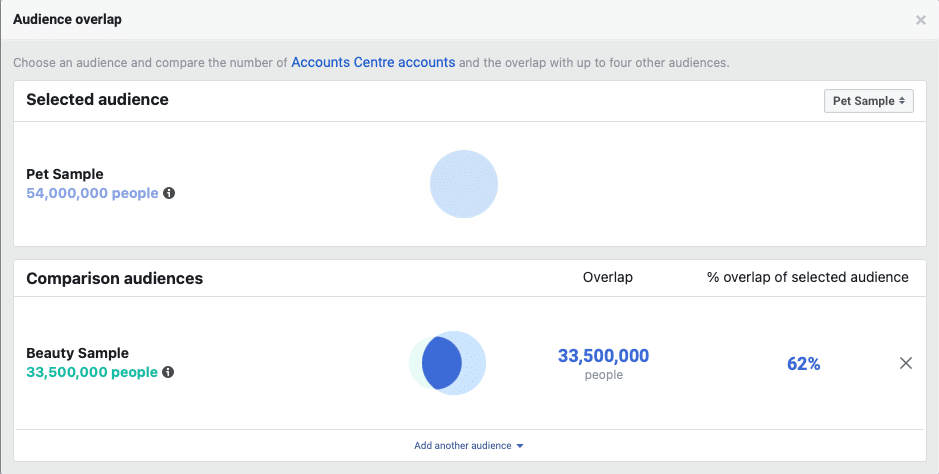What is audience overlap, why does it occur and how to spot it?
Audience overlap is the percentage, or number of members of your audience, that also falls into another existing audience. For example, an audience targeting users with an interest in pet products and an audience targeting an interest in beauty products, the overlap should be minimal.
How to check if you have an overlapping audience?
To check if your audiences overlap and by how much, first create and save the audience in Meta, then:
Go to your Audiences.
Tick the boxes next to the audiences that you want to compare (up to five).
Click Actions > Show audience overlap.
Meta will present a variation of the image below (note you can’t view overlap for custom or lookalike audiences using this tool). In the image below, you can see that 62% of the ‘Pet Sample’ audience is being shared with the ‘Beauty sample’ audience.

What are the risks / issues?
Having overlapping audiences is not necessarily a bad thing, but it can lead to poor delivery of your ad sets. This is because when ad sets from the same advertiser are going to end up in the same auction (meaning they’re targeting similar audiences), Meta will enter the ad set with the best performance history and prevents the ads from competing, so these ads will not be visible. Meta prevents your ads from competing against each other, which can drive up costs and lead to inefficient use of your budget. As such, it is generally best practice to use one of the solutions in this article to prevent audience overlap. An exception to this would be for campaigns that have different objectives, it is less important to reduce audience overlap in this case.
How to solve audience overlap?
There are two ways of solving audience overlap, each with their own drawbacks, but we’ve found that one is better than the other.
The first is to refine your targeting. This can be done in a few ways. You could start by targeting using age, gender or location, which would by default reduce the audience overlap between two otherwise identical audiences to zero. However, this would only apply if it would benefit you to adjust bidding or creative between different audiences.
Another option is to refine your targeting through exclusions. By this, we mean by excluding the targeting used in other ad sets for a given campaign. For example, if you have one ad set targeting an interest in pet products, and another in beauty products, you would exclude the interests relating to beauty products within the pet ad set, and vice versa. This would ensure no audience overlap. However, you would miss out on a potentially highly valuable audience, found in the overlapped audience, e.g. those interested in both pet and beauty products. Using this method, the overlapped audience would not be targeted at all and this could impact campaign performance.
The other method to solve audience overlap is to consolidate your audiences. Consolidating your audience can be done by either adding all of the relevant targeting options to one campaign, merging your smaller audiences, or by using broader targeting options that cover all of the relevant audiences used in the smaller audiences (e.g. an interest in discounts and budget shopping for a brand offering multiple product categories at great prices).
The downside of consolidating your audiences is that, if for example your account promoted products from beauty, pet and home/garden categories, there is a chance an ad showing a pet product will be down to an audience member who is only interested in pets. There is also the risk that only ads from a specific product category are shown, eating up the entire ad set budget, meaning some ads, or product categories won’t be shown.
Fortunately, this problem is minimised because of Metas strong algorithm. After testing both the audience refining and consolidation methods with our clients, we’ve found that consolidation tends to offer the best performance. As a rule of thumb, it’s best to leave the algorithm to do what it does best, find people who want to complete the goal you’ve set.
Consolidation and refinement are opposite ways of solving the problem. (One makes an audience larger, the other makes an audience smaller.) The best choice is different for each situation. However, a useful idea to keep in mind when deciding is: If two audiences are distinct enough that you set different bids for ad sets targeting one compared to the other, try keeping them separate and refining them further. If not, try consolidating them and combining their budgets.



